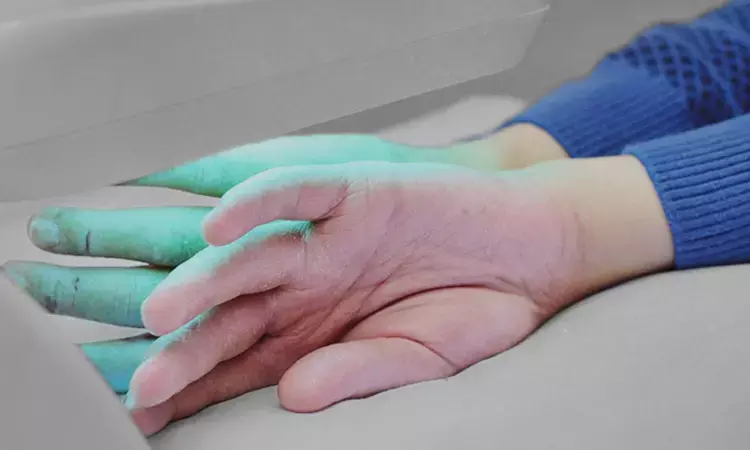- Home
- Medical news & Guidelines
- Anesthesiology
- Cardiology and CTVS
- Critical Care
- Dentistry
- Dermatology
- Diabetes and Endocrinology
- ENT
- Gastroenterology
- Medicine
- Nephrology
- Neurology
- Obstretics-Gynaecology
- Oncology
- Ophthalmology
- Orthopaedics
- Pediatrics-Neonatology
- Psychiatry
- Pulmonology
- Radiology
- Surgery
- Urology
- Laboratory Medicine
- Diet
- Nursing
- Paramedical
- Physiotherapy
- Health news
- Fact Check
- Bone Health Fact Check
- Brain Health Fact Check
- Cancer Related Fact Check
- Child Care Fact Check
- Dental and oral health fact check
- Diabetes and metabolic health fact check
- Diet and Nutrition Fact Check
- Eye and ENT Care Fact Check
- Fitness fact check
- Gut health fact check
- Heart health fact check
- Kidney health fact check
- Medical education fact check
- Men's health fact check
- Respiratory fact check
- Skin and hair care fact check
- Vaccine and Immunization fact check
- Women's health fact check
- AYUSH
- State News
- Andaman and Nicobar Islands
- Andhra Pradesh
- Arunachal Pradesh
- Assam
- Bihar
- Chandigarh
- Chattisgarh
- Dadra and Nagar Haveli
- Daman and Diu
- Delhi
- Goa
- Gujarat
- Haryana
- Himachal Pradesh
- Jammu & Kashmir
- Jharkhand
- Karnataka
- Kerala
- Ladakh
- Lakshadweep
- Madhya Pradesh
- Maharashtra
- Manipur
- Meghalaya
- Mizoram
- Nagaland
- Odisha
- Puducherry
- Punjab
- Rajasthan
- Sikkim
- Tamil Nadu
- Telangana
- Tripura
- Uttar Pradesh
- Uttrakhand
- West Bengal
- Medical Education
- Industry
Home-Based UV-B Phototherapy as Effective as Office-Based Treatment for Psoriasis, LITE Trial Reveals

USA: A recent randomized clinical trial known as the LITE trial has revealed that home-based phototherapy is as effective as office-based phototherapy for treating psoriasis in everyday clinical practice while also presenting a lower burden for patients. The findings were published online in JAMA Dermatology.
Psoriasis, a chronic autoimmune condition characterized by the rapid growth of skin cells, affects millions worldwide, causing discomfort and impacting quality of life. Treatment options typically include topical medications, systemic therapies, and phototherapy, which utilizes ultraviolet light to slow skin cell growth. Traditionally, narrowband UV-B phototherapy has been administered in clinical settings, requiring regular visits to healthcare facilities. However, this can pose challenges for patients in terms of travel, time commitment, and associated costs.
While home-based phototherapy is preferred by patients, clinical data is limited, especially concerning its effectiveness in individuals with darker skin. Considering this, Joel M. Gelfand, Department of Dermatology, University of Pennsylvania, Philadelphia, and colleagues aimed to evaluate the effectiveness of home-based versus office-based narrowband UV-B phototherapy for psoriasis.
For this purpose, the researchers conducted the Light Treatment Effectiveness study, an investigator-initiated, pragmatic, open-label, parallel-group, multicenter, noninferiority randomized clinical trial in routine care across 42 academic and private dermatology practices in the USA. Enrollment was from 2019 to 2023, with follow-up extending through June 2024. Participants included individuals aged 12 years and older with plaque or guttate psoriasis who were eligible for home- and office-based phototherapy.
Participants were randomly assigned to receive either a home narrowband UV-B machine with guided mode dosimetry or routine care with office-based narrowband UV-B treatment for 12 weeks, followed by an additional 12-week observation period.
The coprimary effectiveness outcomes were assessed using the Physician Global Assessment (PGA), which was categorized as clear or almost clear skin (score of ≤1) at the end of the intervention period, and the Dermatology Life Quality Index (DLQI), where a score of 5 or lower indicated no to small effects on quality of life at week 12.
The study led to the following findings:
- Of 783 patients enrolled (mean age, 48.0 years; 48.0% were females), 393 received home-based phototherapy and 390 received office-based phototherapy, with 44.7% having skin phototype (SPT) I/II, 44.7% having SPT III/IV, and 10.6% having SPT V/VI.
- A total of 93 patients were receiving systemic treatment. At baseline, the mean PGA was 2.7, and DLQI was 12.2.
- At week 12, 32.8% of patients receiving home-based phototherapy and 25.6% receiving office-based phototherapy achieved clear/almost clear skin, and 52.4% and 33.6% achieved DLQI of 5 or lower, respectively.
- Home-based phototherapy was noninferior to office-based phototherapy for PGA and DLQI in the overall population and across all SPTs.
- Home-based phototherapy, compared to office-based phototherapy, was associated with better treatment adherence (51.4% patients versus 15.9% patients), lower burden of indirect costs to patients, and more episodes of persistent erythema (5.9% treatments versus 46 of 1.2% treatments).
- Both treatments were well tolerated, and there were no discontinuations due to adverse events.
In this randomized clinical trial, the authors found that home-based phototherapy was noninferior to office-based phototherapy for all specified treatment protocols, achieving comparable results for both patient- and physician-reported outcomes. Additionally, home-based phototherapy proved to be significantly less burdensome for patients and resulted in higher treatment adherence than office-based options. Both methods of phototherapy yielded excellent outcomes for patients.
The authors emphasize the need to enhance the accessibility of these safe, effective, and relatively affordable treatment options in the current landscape of psoriasis therapeutics.
Reference:
Gelfand JM, Armstrong AW, Lim HW, et al. Home- vs Office-Based Narrowband UV-B Phototherapy for Patients With Psoriasis: The LITE Randomized Clinical Trial. JAMA Dermatol. Published online September 25, 2024. doi:10.1001/jamadermatol.2024.3897
Dr Kamal Kant Kohli-MBBS, DTCD- a chest specialist with more than 30 years of practice and a flair for writing clinical articles, Dr Kamal Kant Kohli joined Medical Dialogues as a Chief Editor of Medical News. Besides writing articles, as an editor, he proofreads and verifies all the medical content published on Medical Dialogues including those coming from journals, studies,medical conferences,guidelines etc. Email: drkohli@medicaldialogues.in. Contact no. 011-43720751


